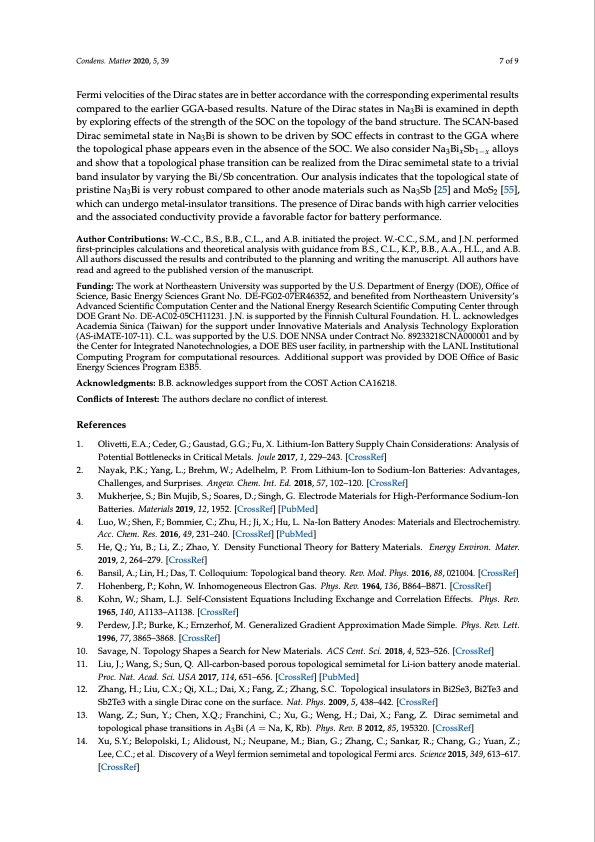
PDF Publication Title:
Text from PDF Page: 007
Condens. Matter 2020, 5, 39 7 of 9 Fermi velocities of the Dirac states are in better accordance with the corresponding experimental results compared to the earlier GGA-based results. Nature of the Dirac states in Na3Bi is examined in depth by exploring effects of the strength of the SOC on the topology of the band structure. The SCAN-based Dirac semimetal state in Na3Bi is shown to be driven by SOC effects in contrast to the GGA where the topological phase appears even in the absence of the SOC. We also consider Na3BixSb1−x alloys and show that a topological phase transition can be realized from the Dirac semimetal state to a trivial band insulator by varying the Bi/Sb concentration. Our analysis indicates that the topological state of pristine Na3Bi is very robust compared to other anode materials such as Na3Sb [25] and MoS2 [55], which can undergo metal-insulator transitions. The presence of Dirac bands with high carrier velocities and the associated conductivity provide a favorable factor for battery performance. Author Contributions: W.-C.C., B.S., B.B., C.L., and A.B. initiated the project. W.-C.C., S.M., and J.N. performed first-principles calculations and theoretical analysis with guidance from B.S., C.L., K.P., B.B., A.A., H.L., and A.B. All authors discussed the results and contributed to the planning and writing the manuscript. All authors have read and agreed to the published version of the manuscript. Funding: The work at Northeastern University was supported by the U.S. Department of Energy (DOE), Office of Science, Basic Energy Sciences Grant No. DE-FG02-07ER46352, and benefited from Northeastern University’s Advanced Scientific Computation Center and the National Energy Research Scientific Computing Center through DOE Grant No. DE-AC02-05CH11231. J.N. is supported by the Finnish Cultural Foundation. H. L. acknowledges Academia Sinica (Taiwan) for the support under Innovative Materials and Analysis Technology Exploration (AS-iMATE-107-11). C.L. was supported by the U.S. DOE NNSA under Contract No. 89233218CNA000001 and by the Center for Integrated Nanotechnologies, a DOE BES user facility, in partnership with the LANL Institutional Computing Program for computational resources. Additional support was provided by DOE Office of Basic Energy Sciences Program E3B5. Acknowledgments: B.B. acknowledges support from the COST Action CA16218. Conflicts of Interest: The authors declare no conflict of interest. References 1. Olivetti, E.A.; Ceder, G.; Gaustad, G.G.; Fu, X. Lithium-Ion Battery Supply Chain Considerations: Analysis of Potential Bottlenecks in Critical Metals. Joule 2017, 1, 229–243. [CrossRef] 2. Nayak, P.K.; Yang, L.; Brehm, W.; Adelhelm, P. From Lithium-Ion to Sodium-Ion Batteries: Advantages, Challenges, and Surprises. Angew. Chem. Int. Ed. 2018, 57, 102–120. [CrossRef] 3. Mukherjee, S.; Bin Mujib, S.; Soares, D.; Singh, G. Electrode Materials for High-Performance Sodium-Ion Batteries. Materials 2019, 12, 1952. [CrossRef] [PubMed] 4. Luo, W.; Shen, F.; Bommier, C.; Zhu, H.; Ji, X.; Hu, L. Na-Ion Battery Anodes: Materials and Electrochemistry. Acc. Chem. Res. 2016, 49, 231–240. [CrossRef] [PubMed] 5. He, Q.; Yu, B.; Li, Z.; Zhao, Y. Density Functional Theory for Battery Materials. Energy Environ. Mater. 2019, 2, 264–279. [CrossRef] 6. Bansil, A.; Lin, H.; Das, T. Colloquium: Topological band theory. Rev. Mod. Phys. 2016, 88, 021004. [CrossRef] 7. Hohenberg, P.; Kohn, W. Inhomogeneous Electron Gas. Phys. Rev. 1964, 136, B864–B871. [CrossRef] 8. Kohn, W.; Sham, L.J. Self-Consistent Equations Including Exchange and Correlation Effects. Phys. Rev. 1965, 140, A1133–A1138. [CrossRef] 9. Perdew, J.P.; Burke, K.; Ernzerhof, M. Generalized Gradient Approximation Made Simple. Phys. Rev. Lett. 1996, 77, 3865–3868. [CrossRef] 10. Savage, N. Topology Shapes a Search for New Materials. ACS Cent. Sci. 2018, 4, 523–526. [CrossRef] 11. Liu, J.; Wang, S.; Sun, Q. All-carbon-based porous topological semimetal for Li-ion battery anode material. Proc. Nat. Acad. Sci. USA 2017, 114, 651–656. [CrossRef] [PubMed] 12. Zhang, H.; Liu, C.X.; Qi, X.L.; Dai, X.; Fang, Z.; Zhang, S.C. Topological insulators in Bi2Se3, Bi2Te3 and Sb2Te3 with a single Dirac cone on the surface. Nat. Phys. 2009, 5, 438–442. [CrossRef] 13. Wang, Z.; Sun, Y.; Chen, X.Q.; Franchini, C.; Xu, G.; Weng, H.; Dai, X.; Fang, Z. Dirac semimetal and topological phase transitions in A3Bi (A = Na, K, Rb). Phys. Rev. B 2012, 85, 195320. [CrossRef] 14. Xu, S.Y.; Belopolski, I.; Alidoust, N.; Neupane, M.; Bian, G.; Zhang, C.; Sankar, R.; Chang, G.; Yuan, Z.; Lee, C.C.; et al. Discovery of a Weyl fermion semimetal and topological Fermi arcs. Science 2015, 349, 613–617. [CrossRef]PDF Image | Topological Dirac Semimetal Phase in Bismuth Based Anode Materials for Sodium-Ion Batteries

PDF Search Title:
Topological Dirac Semimetal Phase in Bismuth Based Anode Materials for Sodium-Ion BatteriesOriginal File Name Searched:
condensedmatter-05-00039-v3.pdfDIY PDF Search: Google It | Yahoo | Bing
Sulfur Deposition on Carbon Nanofibers using Supercritical CO2 Sulfur Deposition on Carbon Nanofibers using Supercritical CO2. Gamma sulfur also known as mother of pearl sulfur and nacreous sulfur... More Info
CO2 Organic Rankine Cycle Experimenter Platform The supercritical CO2 phase change system is both a heat pump and organic rankine cycle which can be used for those purposes and as a supercritical extractor for advanced subcritical and supercritical extraction technology. Uses include producing nanoparticles, precious metal CO2 extraction, lithium battery recycling, and other applications... More Info
| CONTACT TEL: 608-238-6001 Email: greg@infinityturbine.com | RSS | AMP |